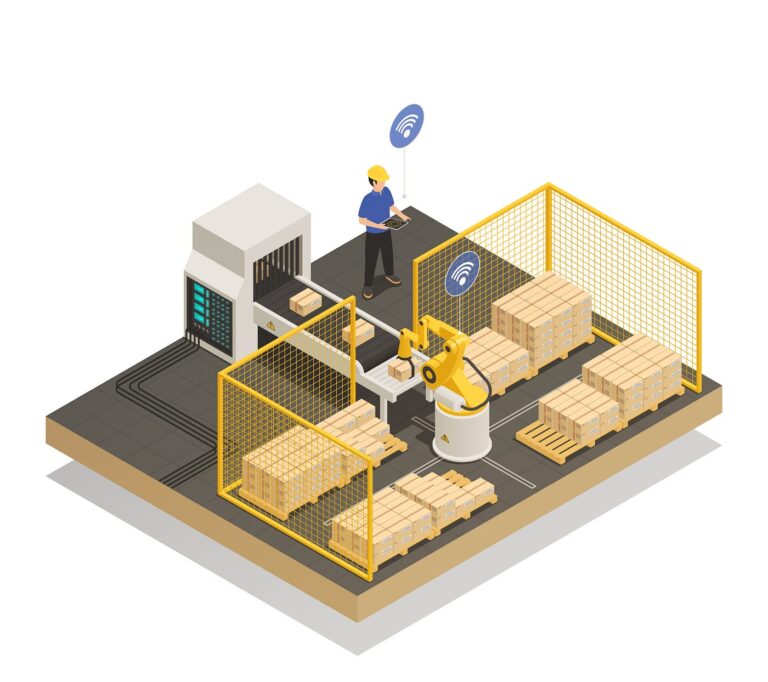WMS with AI and Machine Learning
- Why WMSOne Stands Out In Warehouse Management - December 30, 2024
- The Future of Warehouse Inventory Management in 2025 - December 9, 2024
- Cold Storage Warehouse: Keeping Food Fresh And Safe - October 3, 2024
Introduction:
In the ever-evolving landscape of warehouse management, AI and Machine Learning have emerged as transformative technologies, promising unprecedented levels of efficiency and accuracy. To enhance productivity, accuracy, and responsiveness, many companies are turning to AI and Machine Learning (ML) technologies. This case study examines how a leading logistics company successfully implemented AI and ML into its Warehouse Management System (WMS), resulting in significant improvements across various key performance indicators (KPIs).
Client Background:
The client, a logistics corporation, operates a network of warehouses spanning multiple regions. With a diverse range of products and fluctuating demand patterns, they faced challenges in inventory optimization, order fulfillment, and resource allocation.
Challenges:
- Inventory Optimization: Inefficient inventory management led to stockouts, excess inventory, and increased carrying costs.
- Slow Order Fulfillment: Orders often took longer than expected to be fulfilled due to inefficient picking processes. Manual picking routes, designed without data-driven insights, led to unnecessary back-and-forth movements for pickers.
- Resource Allocation: Suboptimal resource allocation resulted in underutilized capacity and high operational costs.
- Suboptimal Warehouse Layout: The warehouse layout, established years ago, hadn’t been updated to reflect changing product popularity and demand patterns. This resulted in high-demand items being located far from picking zones, further extending picking times.
Solution:
The company collaborated with AI and ML experts to integrate advanced algorithms into its existing WMS. The solution comprised several components:
- Demand Forecasting: Utilizing historical sales data, seasonality patterns, and external factors (e.g., promotions, market trends), AI algorithms forecasted demand with high accuracy. This enabled proactive inventory management and optimized replenishment strategies.
- Dynamic Routing: ML algorithms analyzed real-time data such as order volume, warehouse layout, and traffic patterns to optimize picking routes. By minimizing travel time and distance, the system improved order fulfillment efficiency and reduced labor costs.
- Predictive Maintenance: AI-powered predictive maintenance models monitored equipment health and performance indicators in real-time. By predicting potential failures before they occur, the system minimized downtime and optimized equipment utilization.
- Resource Optimization: Machine learning algorithms continuously analyzed operational data to optimize resource allocation, including labor, equipment, and storage space. This ensured efficient utilization of resources while maintaining service levels.
Implementation Process:
- Assessment and Planning: The company conducted a comprehensive assessment of its existing WMS and identified areas for improvement. A detailed implementation plan was developed, outlining the timeline, budget, and key performance metrics.
- Data Integration:Data from various sources, including ERP systems, sensors, and IoT devices, was integrated into a centralized data platform. Data cleansing and preprocessing techniques were applied to ensure data quality and consistency.
- Model Development:The company developed and trained AI and ML models using historical data and domain expertise. They evaluated model performance using validation datasets and made iterative improvements to enhance accuracy and robustness.
- Integration and Testing: The company integrated the AI-powered modules into the existing WMS infrastructure and conducted rigorous testing to validate system functionality and performance. They conducted user training programs to familiarize warehouse staff with the new system.
- Deployment and Monitoring: The company deployed the enhanced WMS across all warehouse facilities and continuously monitored performance metrics in real-time. They established feedback mechanisms to gather insights from users and stakeholders, enabling continuous improvement and optimization.
Results:
- Improved Inventory Accuracy: AI-driven demand forecasting reduced stock outs by 30% and excess inventory by 20%, leading to improved inventory accuracy and reduced carrying costs.
- Enhanced Order Fulfillment: Dynamic routing algorithms reduced order picking time by 25% and error rates by 15%, resulting in faster order fulfillment and improved customer satisfaction.
- Cost Savings: Predictive maintenance models decreased equipment downtime by 20% and maintenance costs by 15%, leading to significant cost savings.
- Optimized Resource Allocation: ML-based resource optimization algorithms improved labor productivity by 18% and warehouse space utilization by 10%, resulting in better resource allocation and reduced operational costs.
Beyond the Numbers: The Human Factor
The success story goes beyond just numbers. The implementation of AI and Machine Learning not only improved efficiency but also positively impacted the workforce. Pickers, relieved of tedious and error-prone tasks, were able to focus on more strategic activities. The technology also empowered them with real-time information, allowing them to work smarter and faster.
Lessons Learned: A Roadmap for Success
This case study serves as a roadmap for other companies looking to revolutionize their warehouses with AI and ML. Here are some key takeaways:
- Data is King: The success of AI and ML solutions heavily relies on the quality and quantity of data fed into the system. Investing in data collection and analysis is crucial.
- Change Management is Essential: Implementing AI requires a well-defined change management strategy. Training and support for warehouse staff are essential to ensure smooth adoption of new technologies.
- Continuous Improvement is Key: AI and Machine Learning systems are not static. Regularly monitoring and evaluating their
Conclusion:
By leveraging AI and Machine Learning technologies, the logistics company transformed its warehouse management operations, achieving significant improvements in efficiency, accuracy, and cost-effectiveness. The successful implementation of AI-powered WMS not only enhanced operational performance but also positioned the company for future growth and competitiveness in the dynamic logistics industry.





